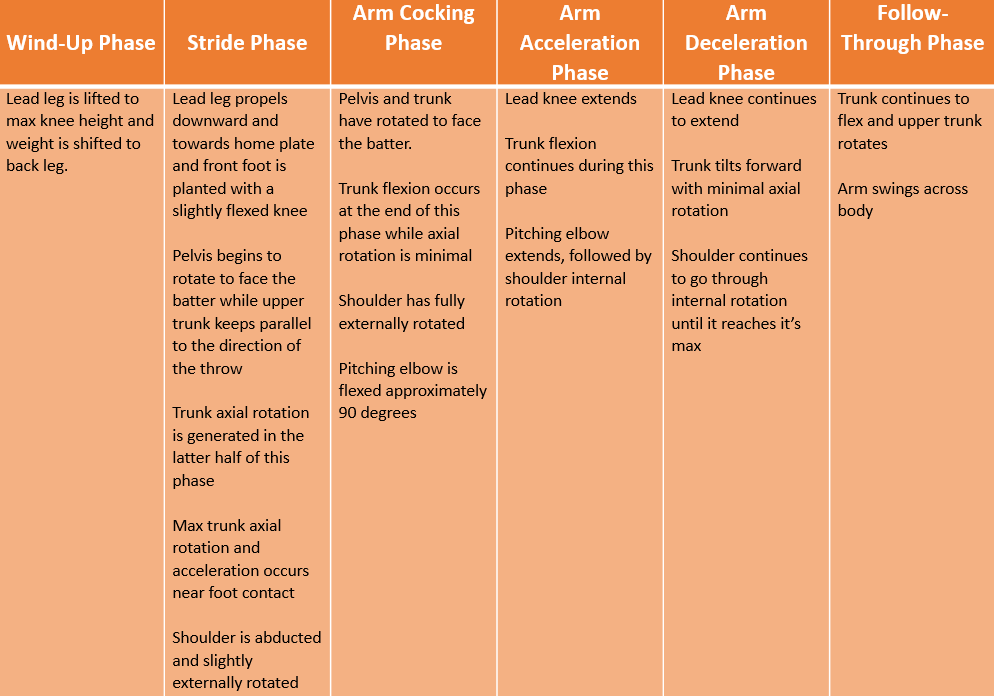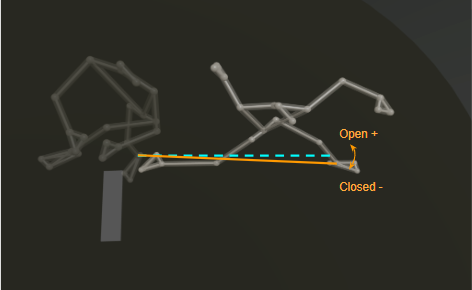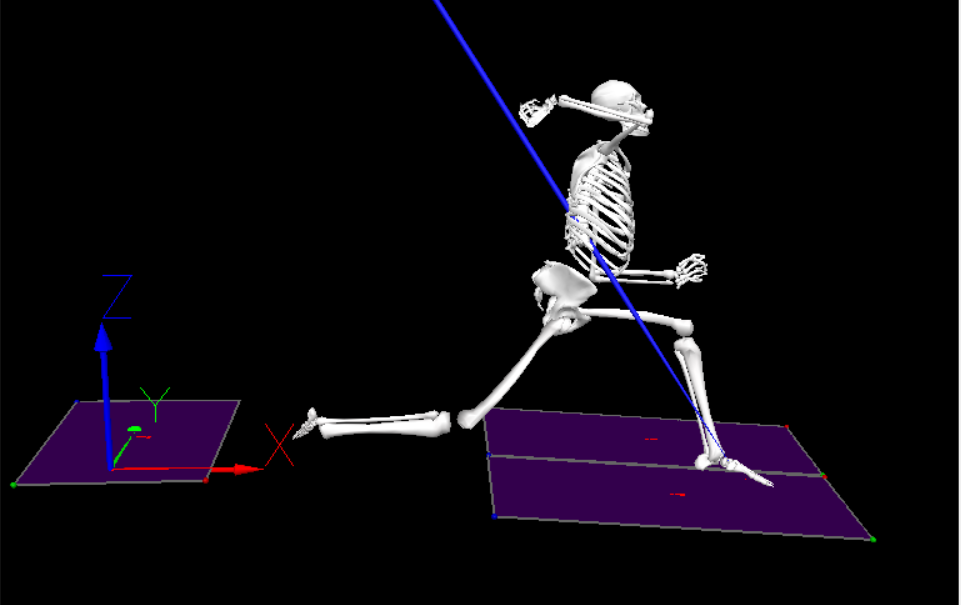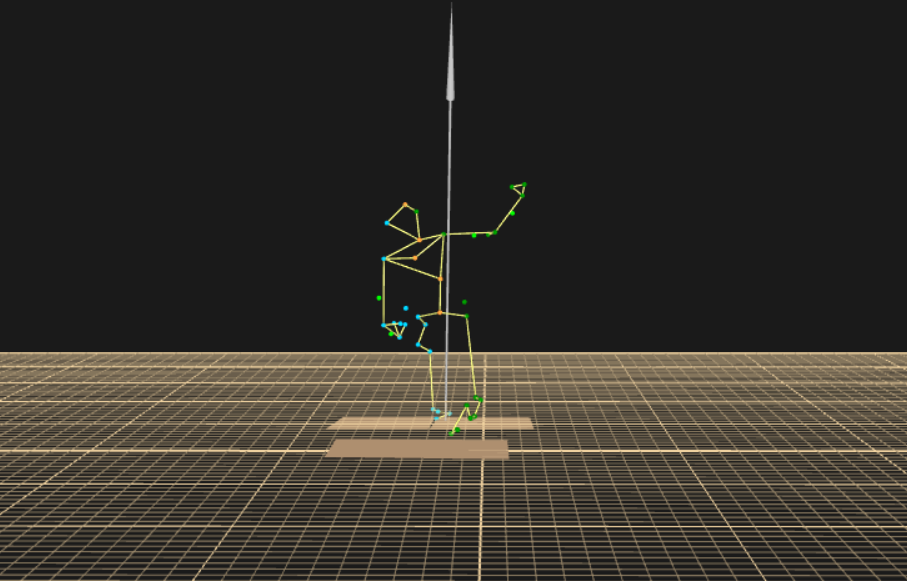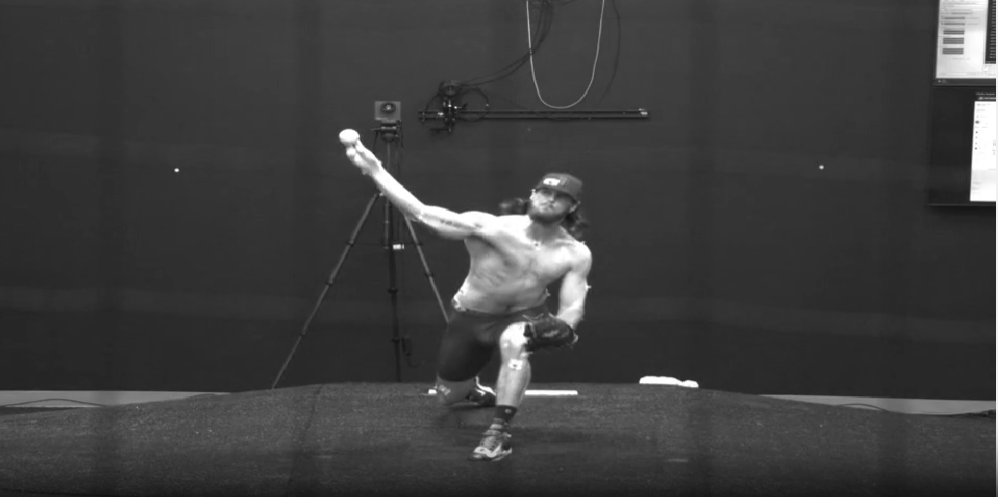PITCHING
PHASES
Description:
In order to interpret the mechanics of a pitch more effectively, the pitching motion is divided into key phases: wind-up, stride, arm cocking, arm acceleration, arm deceleration, and follow-through.
During the wind-up, the pitcher places his back foot on the rubber and the front leg is then lifted. The wind-up phase ends when the pitcher reaches maximum knee height. From maximum front knee height to front foot contact with the mound, the pitcher is in the stride phase. The arm cocking phase is from front foot contact to maximum external shoulder rotation. The arm acceleration phase is from maximum external shoulder rotation to ball release. The arm deceleration phase is from ball release to maximum shoulder internal rotation, and follow-through is the completion of the pitch after maximum internal shoulder rotation. (Fleisig 2013).
Common Mechanics at Each Phase:
The table below lists the general descriptions of each phase. Individual variations are expected.
Fleisig et al. 2013; Fortenbaugh et al. 2009
METRICS
Biomechanics is used in many different fields and areas of study. In pitching, we as a group have defined metrics of interest when observing our pitchers, also referred to as our KPI’s. Below you will find a shortened list of both the in lab and in game metrics. If there any questions, please feel free to reach out and/or visit our metrics dictionary (link will be provided).
Key Performance Indicators
Stride Length
Stride length describes the distance measured between the back ankle at max knee height and the lead ankle at footstrike in feet.The stride phase starts when the lead leg reaches its max knee height (peak) and ends at foostrike (Seroyer et al 2010). Stride length is identified as the distance from the back leg ankle to the lead ankle, divided by body weight. The lead foot should land with a stride length that is slightly less than the height of the pitcher (85% of the height), and a closed lead foot position for a right-handed pitcher are when the toes are pointing slightly toward third base.
Stride Horizontal Angle (in)
Stride horizontal angle describes the angle formed by the line starting at the back ankle at max knee height in the direction of home plate and the line connecting the back ankle at max knee height and the lead ankle at footstrike. The further away from the reference line the lead foot lands, the greater the angle will be. A positive angle represents an open stride, and a negative angle represents a closed stride.
Hip-Shoulder Separation Angle at Footstrike
Hip-shoulder separation angle at foot contact is the degree of separation between your trunk segment (shown by drawing a vector through the left and right shoulders) and your pelvis segment (shown by drawing a vector through the left and right hips) at the moment of footstrike. Hip shoulder separation describes the angular difference between the rotation of the trunk and pelvis. A negative value represents counter-rotation of the trunk relative to the pelvis, which is typically the case at footstrike for pitchers. This well-known metric is reflected in coaches and trainers’ messages to pitchers to “stay closed” prior to footstrike with the aim to get pitchers to rotate their hips towards home plate while maintaining a closed trunk/shoulders.
Max External Rotation (MER)
Max pitching shoulder external rotation (MER) describes the shoulder external rotation angle when the arm is at peak layback. This is one variable that is highly related to locity.
Arm Slot at Release
Arm slot describes the angle between the shoulder-wrist line and an imaginary vertical line from the ground up at release. The less/smaller the value, the higher the arm slot will be. Consider this as a clock with 0° being equivalent to 12 o'clock.
Shoulder External Rotation at Release
Pitching shoulder internal rotation describes the relative motion between the upper arm and the trunk. Internal/external rotation occurs about the long axis of the upper arm and controls the arc of motion of the hand/ball during layback and arm acceleration. At release the shoulder almost always has some degree of external rotation and will have a negative value. Because the elbow is almost fully extended at release, internal/external rotation works similar to pronation/supination.
Less external rotation will move the hand to the inside of the ball, similar to a pronated position, and more external rotation will keep the hand on the outside of the ball, similar to a supinated position.
Lead Knee
Lead knee blocked - the lead knee extension or bracing (-) for impact as they go through their follow-through of the pitch and drifting (+) describes the knee flexion difference from footstrike to release. We often here coaches telling players to extend or straighten the landing leg back for effective bracing. However, tightness with the hamstring could be a reason as to why the chest is not out in front in the throw and the front leg having the bend rather than extend is due to the hamstring being inflexible. Understanding the types of muscle contractions, (concentric, eccentric, and isometric contractions) and the hamstring muscle are important for tension building and forward momentum. The potential idea that those that block better throw faster because of the redirection of kinetic energy.
This determines how well the player is “putting the brakes on” or “sinking” into that lead knee. Knee flexing even further during the deceleration phase of the cycle hinders the chest from leaning forward, so we tend to see the player fairly upright/tall, and this can potentially be due to issues with their sequencing. Research has found that when pitchers utilize a lead leg bracing technique this facilitates increases lead knee extension and can contribute to faster ball velocity (Dowling et al 2022).
Trunk Forward Bend at Release
Trunk forward bend describes the amount of trunk bend in the direction that the pitcher's torso is facing. At release, the trunk is oriented towards home; a higher trunk forward bend indicates more bending towards the plate.
Kinematic Sequence
The kinematic sequence (KS), also referred to as the kinetic chain, is a term that explains the sequence in which certain body segments rotate in order to transfer to the baseball. The kinematic sequence is identified by each segments peak angular velocity and when it is occurring during the pitching motion.



